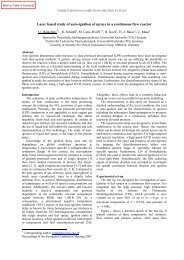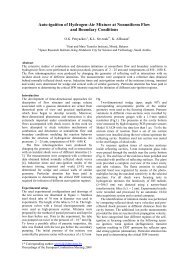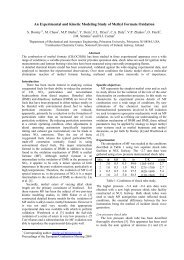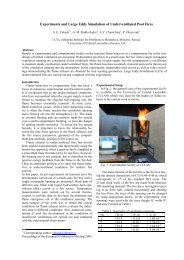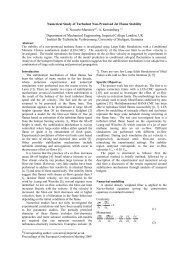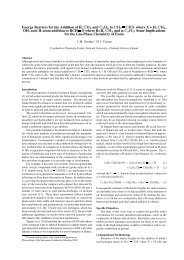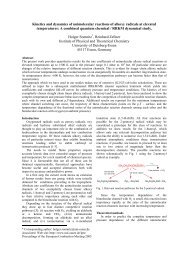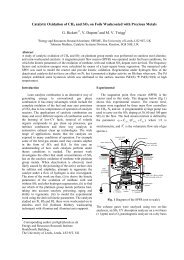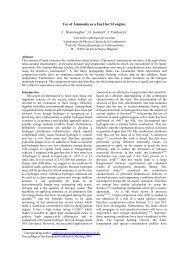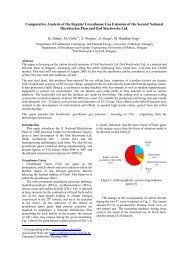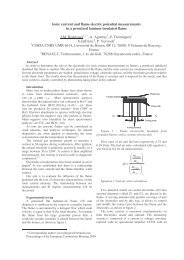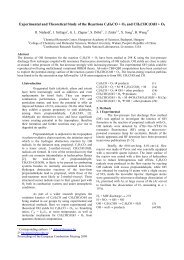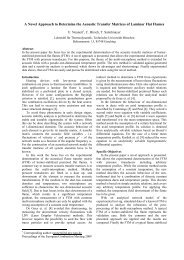On the Effect of Air Temperature on Mild Flameless Combustion ...
On the Effect of Air Temperature on Mild Flameless Combustion ...
On the Effect of Air Temperature on Mild Flameless Combustion ...
You also want an ePaper? Increase the reach of your titles
YUMPU automatically turns print PDFs into web optimized ePapers that Google loves.
<str<strong>on</strong>g>On</str<strong>on</strong>g> <str<strong>on</strong>g>the</str<strong>on</strong>g> <str<strong>on</strong>g>Effect</str<strong>on</strong>g> <str<strong>on</strong>g>of</str<strong>on</strong>g> <str<strong>on</strong>g>Air</str<strong>on</strong>g> <str<strong>on</strong>g>Temperature</str<strong>on</strong>g> <strong>on</strong> <strong>Mild</strong> <strong>Flameless</strong> Combusti<strong>on</strong> Regime<br />
<str<strong>on</strong>g>of</str<strong>on</strong>g> High <str<strong>on</strong>g>Temperature</str<strong>on</strong>g> Furnace<br />
C. Rottier 1* , C. Lacour 1 , G. Godard 1 , B. Taupin 1 , L. Porcher<strong>on</strong> 2 , R. Hauguel 2 , S.Carpentier 2 ,<br />
A.M. Boukhalfa 1 , D. H<strong>on</strong>oré 1<br />
1 CORIA – CNRS, Université et INSA de Rouen, Saint Etienne du Rouvray, France<br />
2 GDF SUEZ, Research and Innovati<strong>on</strong> Divisi<strong>on</strong>, Saint Denis La Plaine, France<br />
Abstract<br />
This paper presents an experimental study <str<strong>on</strong>g>of</str<strong>on</strong>g> <str<strong>on</strong>g>the</str<strong>on</strong>g> effect <str<strong>on</strong>g>of</str<strong>on</strong>g> air preheating temperature <strong>on</strong> <str<strong>on</strong>g>the</str<strong>on</strong>g> main features <str<strong>on</strong>g>of</str<strong>on</strong>g> mild<br />
flameless combusti<strong>on</strong> obtained in a laboratory-scale furnace. <strong>Mild</strong> flameless combusti<strong>on</strong> regime is c<strong>on</strong>served<br />
whatever <str<strong>on</strong>g>the</str<strong>on</strong>g> air temperature varying from 838 K to ambient value. No visible flame is observed. Main aerodynamic<br />
features <str<strong>on</strong>g>of</str<strong>on</strong>g> <str<strong>on</strong>g>the</str<strong>on</strong>g> flow at <str<strong>on</strong>g>the</str<strong>on</strong>g> exit <str<strong>on</strong>g>of</str<strong>on</strong>g> <str<strong>on</strong>g>the</str<strong>on</strong>g> burner are similar with and without air preheating. Large momentum <str<strong>on</strong>g>of</str<strong>on</strong>g><br />
methane and air turbulent jets favours <str<strong>on</strong>g>the</str<strong>on</strong>g> entrainment <str<strong>on</strong>g>of</str<strong>on</strong>g> recirculating flue gas and <str<strong>on</strong>g>the</str<strong>on</strong>g>n <str<strong>on</strong>g>the</str<strong>on</strong>g> progressive diluti<strong>on</strong> <str<strong>on</strong>g>of</str<strong>on</strong>g><br />
reactant by flue gas. Main difference comes from <str<strong>on</strong>g>the</str<strong>on</strong>g> structures <str<strong>on</strong>g>of</str<strong>on</strong>g> <str<strong>on</strong>g>the</str<strong>on</strong>g> reacti<strong>on</strong> z<strong>on</strong>e which are more and more lifted<br />
and NOx emissi<strong>on</strong>s which decrease progressively with air temperature, down to a very low value (4 ppm @3%O2).<br />
Introducti<strong>on</strong><br />
<strong>Mild</strong> flameless combusti<strong>on</strong> is an advanced combusti<strong>on</strong><br />
technique designed to reduce NOx emissi<strong>on</strong>s and<br />
increase energy efficiency <str<strong>on</strong>g>of</str<strong>on</strong>g> high temperature furnaces.<br />
The use <str<strong>on</strong>g>of</str<strong>on</strong>g> a recuperative or regenerative system in a<br />
burner allows <str<strong>on</strong>g>the</str<strong>on</strong>g> optimisati<strong>on</strong> <str<strong>on</strong>g>of</str<strong>on</strong>g> <str<strong>on</strong>g>the</str<strong>on</strong>g> energy efficiency<br />
thanks to <str<strong>on</strong>g>the</str<strong>on</strong>g> heat transfer from hot exhaust gases to<br />
inlet combusting air [1, 2]. The main drawback <str<strong>on</strong>g>of</str<strong>on</strong>g><br />
regenerative burner is <str<strong>on</strong>g>the</str<strong>on</strong>g> very high temperature that<br />
could be reached in <str<strong>on</strong>g>the</str<strong>on</strong>g> flame because <str<strong>on</strong>g>of</str<strong>on</strong>g> air preheating.<br />
This favours <str<strong>on</strong>g>the</str<strong>on</strong>g> NO formati<strong>on</strong> from <str<strong>on</strong>g>the</str<strong>on</strong>g>rmal route and<br />
thus very large NOx emissi<strong>on</strong>s, that may be over <str<strong>on</strong>g>the</str<strong>on</strong>g><br />
regulati<strong>on</strong> limits.<br />
<str<strong>on</strong>g>Air</str<strong>on</strong>g> and fuel staging is <strong>on</strong>e <str<strong>on</strong>g>of</str<strong>on</strong>g> <str<strong>on</strong>g>the</str<strong>on</strong>g> most comm<strong>on</strong> primary<br />
strategy for reducing NOx emissi<strong>on</strong>s. It is used in<br />
several combusti<strong>on</strong> applicati<strong>on</strong>s notably in high<br />
temperature furnace [3]. <strong>Mild</strong> flameless combusti<strong>on</strong> has<br />
been developed when applying fuel or air staging to<br />
regenerative burners to <str<strong>on</strong>g>the</str<strong>on</strong>g> maximum level <str<strong>on</strong>g>of</str<strong>on</strong>g> a total<br />
staging, i.e. to a c<strong>on</strong>figurati<strong>on</strong> where air and fuel<br />
injecti<strong>on</strong>s are distant. Because <str<strong>on</strong>g>of</str<strong>on</strong>g> <str<strong>on</strong>g>the</str<strong>on</strong>g> large jet velocities<br />
<str<strong>on</strong>g>of</str<strong>on</strong>g> fuel and air associated to this staging, str<strong>on</strong>g<br />
recirculati<strong>on</strong> <str<strong>on</strong>g>of</str<strong>on</strong>g> flue gas occurs in <str<strong>on</strong>g>the</str<strong>on</strong>g> combusti<strong>on</strong><br />
chamber. Mixing <str<strong>on</strong>g>of</str<strong>on</strong>g> recirculating combusti<strong>on</strong> products<br />
with air and fuel induces this specific diluted<br />
combusti<strong>on</strong> regime named HiTAC combusti<strong>on</strong>,<br />
flameless combusti<strong>on</strong> or mild combusti<strong>on</strong> [2, 4, 5]. Its<br />
main characteristics are <str<strong>on</strong>g>the</str<strong>on</strong>g> global homogeneity <str<strong>on</strong>g>of</str<strong>on</strong>g> heat<br />
release, <str<strong>on</strong>g>the</str<strong>on</strong>g> n<strong>on</strong> visibility <str<strong>on</strong>g>of</str<strong>on</strong>g> <str<strong>on</strong>g>the</str<strong>on</strong>g> reacti<strong>on</strong> z<strong>on</strong>es, and <str<strong>on</strong>g>the</str<strong>on</strong>g><br />
very low NOx emissi<strong>on</strong>s which can be divided by ten<br />
compared to a c<strong>on</strong>venti<strong>on</strong>al regenerative burner [6].<br />
Although this technique has been applied successfully<br />
<strong>on</strong> industrial units, <str<strong>on</strong>g>the</str<strong>on</strong>g> impact <str<strong>on</strong>g>of</str<strong>on</strong>g> several key parameters<br />
<strong>on</strong> combusti<strong>on</strong> characteristics are not fully understood<br />
yet. This has motivated several experimental studies at<br />
semi-industrial scale [7 – 12], as well as laboratory scale<br />
[2, 13 – 19].<br />
* Corresp<strong>on</strong>ding author: rottier@coria.fr<br />
Proceedings <str<strong>on</strong>g>of</str<strong>on</strong>g> <str<strong>on</strong>g>the</str<strong>on</strong>g> European Combusti<strong>on</strong> Meeting<br />
Specific objectives<br />
Our approach is to reproduce mild flameless<br />
combusti<strong>on</strong> regime with a burner c<strong>on</strong>figurati<strong>on</strong> close to<br />
<str<strong>on</strong>g>the</str<strong>on</strong>g> real commercial industrial <strong>on</strong>es in a laboratory-scale<br />
facility enabling applicati<strong>on</strong>s <str<strong>on</strong>g>of</str<strong>on</strong>g> several measurements<br />
techniques. This study follows a previous study<br />
performed at semi-industrial scale at <str<strong>on</strong>g>the</str<strong>on</strong>g> GDF SUEZ<br />
R&D center [10]. Some results <str<strong>on</strong>g>of</str<strong>on</strong>g> <str<strong>on</strong>g>the</str<strong>on</strong>g> study <str<strong>on</strong>g>of</str<strong>on</strong>g> mild<br />
flameless combusti<strong>on</strong> obtained in <str<strong>on</strong>g>the</str<strong>on</strong>g> laboratory-scale<br />
facility have been already presented when preheating<br />
combusti<strong>on</strong> air [17]. The present communicati<strong>on</strong> is<br />
focused <strong>on</strong> <str<strong>on</strong>g>the</str<strong>on</strong>g> experimental investigati<strong>on</strong> <str<strong>on</strong>g>of</str<strong>on</strong>g> <str<strong>on</strong>g>the</str<strong>on</strong>g> effect<br />
<str<strong>on</strong>g>of</str<strong>on</strong>g> air temperature <strong>on</strong> <str<strong>on</strong>g>the</str<strong>on</strong>g> main features <str<strong>on</strong>g>of</str<strong>on</strong>g> this original<br />
combusti<strong>on</strong> regime.<br />
The experimental setup<br />
The laboratory-scale mild flameless combusti<strong>on</strong> facility<br />
and some measurement techniques have been already<br />
presented previously [17]. <str<strong>on</strong>g>On</str<strong>on</strong>g>ly main characteristics <str<strong>on</strong>g>of</str<strong>on</strong>g><br />
<str<strong>on</strong>g>the</str<strong>on</strong>g> furnace are reminded here. Some specificities <str<strong>on</strong>g>of</str<strong>on</strong>g> <str<strong>on</strong>g>the</str<strong>on</strong>g><br />
applicati<strong>on</strong> <str<strong>on</strong>g>of</str<strong>on</strong>g> measurements techniques in such high<br />
temperature facility are presented.<br />
The mild flameless combusti<strong>on</strong> facility<br />
The pilot facility, named “FOUR” for Furnace with<br />
Optical accesses and Upstream Recirculati<strong>on</strong>, has a<br />
vertical plane-parallel combusti<strong>on</strong> chamber (0.5 x 0.5<br />
squared secti<strong>on</strong> and 1 m height), made with refractory<br />
materials for a maximum wall temperature <str<strong>on</strong>g>of</str<strong>on</strong>g> 1400 K<br />
(Figure 1). Several openings are set al<strong>on</strong>g in staggered<br />
rows <strong>on</strong> <str<strong>on</strong>g>the</str<strong>on</strong>g> four sides <str<strong>on</strong>g>of</str<strong>on</strong>g> <str<strong>on</strong>g>the</str<strong>on</strong>g> combusti<strong>on</strong> chamber.<br />
These openings can receive an optical window or a<br />
probe stand for detailed measurements in <str<strong>on</strong>g>the</str<strong>on</strong>g> furnace, or<br />
a refractory block to preserve <str<strong>on</strong>g>the</str<strong>on</strong>g>rmal c<strong>on</strong>finement and<br />
measure wall temperature. The burner (Figure 2.)<br />
c<strong>on</strong>sists <str<strong>on</strong>g>of</str<strong>on</strong>g> three coplanar jets: two <str<strong>on</strong>g>of</str<strong>on</strong>g>f-axis methane<br />
injectors (3mm dia.) spaced 101.4 mm apart and set <strong>on</strong>
ei<str<strong>on</strong>g>the</str<strong>on</strong>g>r sides <str<strong>on</strong>g>of</str<strong>on</strong>g> a central air jet (25mm dia.) ending with<br />
a divergent shape (R = 11 mm).<br />
Figure 1 The mild flameless combusti<strong>on</strong> furnace at<br />
laboratory scale.<br />
The centre <str<strong>on</strong>g>of</str<strong>on</strong>g> <str<strong>on</strong>g>the</str<strong>on</strong>g> air jet at <str<strong>on</strong>g>the</str<strong>on</strong>g> exit <str<strong>on</strong>g>of</str<strong>on</strong>g> <str<strong>on</strong>g>the</str<strong>on</strong>g> burner is<br />
defined as <str<strong>on</strong>g>the</str<strong>on</strong>g> origin. The vertical axis al<strong>on</strong>g <str<strong>on</strong>g>the</str<strong>on</strong>g> air jet<br />
corresp<strong>on</strong>ds to <str<strong>on</strong>g>the</str<strong>on</strong>g> y-axis, and <str<strong>on</strong>g>the</str<strong>on</strong>g> x-axis is <str<strong>on</strong>g>the</str<strong>on</strong>g><br />
horiz<strong>on</strong>tal axis crossing <str<strong>on</strong>g>the</str<strong>on</strong>g> centres <str<strong>on</strong>g>of</str<strong>on</strong>g> <str<strong>on</strong>g>the</str<strong>on</strong>g> exits <str<strong>on</strong>g>of</str<strong>on</strong>g> air<br />
and methane injectors.<br />
side view fr<strong>on</strong>t view<br />
Figure 2 Geometry <str<strong>on</strong>g>of</str<strong>on</strong>g> <str<strong>on</strong>g>the</str<strong>on</strong>g> burner.<br />
Combusti<strong>on</strong> air can be preheated up to 850 K thanks to<br />
an electric heater, in order to mimic <str<strong>on</strong>g>the</str<strong>on</strong>g> presence <str<strong>on</strong>g>of</str<strong>on</strong>g> a<br />
regenerative system in <str<strong>on</strong>g>the</str<strong>on</strong>g> burner and to allow<br />
c<strong>on</strong>tinuous operating c<strong>on</strong>diti<strong>on</strong>s.<br />
The reference operating c<strong>on</strong>diti<strong>on</strong>s are a <str<strong>on</strong>g>the</str<strong>on</strong>g>rmal input<br />
<str<strong>on</strong>g>of</str<strong>on</strong>g> 18.5 kW, an equivalence ratio <str<strong>on</strong>g>of</str<strong>on</strong>g> 0.85 and an air<br />
preheating <str<strong>on</strong>g>of</str<strong>on</strong>g> 838 K. In this case, wall temperature is<br />
homogeneous and equal to ~ 1320 K. No visible flame<br />
can be observed in this specific "colorless" combusti<strong>on</strong><br />
mode (Figure 3).<br />
Figure 3 Photograph <str<strong>on</strong>g>of</str<strong>on</strong>g> <str<strong>on</strong>g>the</str<strong>on</strong>g> facility in flameless<br />
combusti<strong>on</strong> regime.<br />
2<br />
Reactive z<strong>on</strong>e visualisati<strong>on</strong> by OH* chemiluminescence<br />
imaging<br />
OH* chemiluminescence imaging has been shown to be<br />
a very c<strong>on</strong>venient technique for <str<strong>on</strong>g>the</str<strong>on</strong>g> visualisati<strong>on</strong> <str<strong>on</strong>g>of</str<strong>on</strong>g><br />
reacti<strong>on</strong> z<strong>on</strong>e structures in high temperature furnace<br />
compared to o<str<strong>on</strong>g>the</str<strong>on</strong>g>r radicals. Indeed in <str<strong>on</strong>g>the</str<strong>on</strong>g> visible range,<br />
CH* and C2* chemiluminescence signals are hardly<br />
discernable from str<strong>on</strong>g global emissi<strong>on</strong>s <str<strong>on</strong>g>of</str<strong>on</strong>g> high<br />
temperature walls. As OH* chemiluminescence occurs<br />
in <str<strong>on</strong>g>the</str<strong>on</strong>g> ultraviolet spectral range, emissi<strong>on</strong>s from high<br />
temperature walls are several orders <str<strong>on</strong>g>of</str<strong>on</strong>g> magnitude less<br />
than in <str<strong>on</strong>g>the</str<strong>on</strong>g> visible range. Images <str<strong>on</strong>g>of</str<strong>on</strong>g> reacti<strong>on</strong> z<strong>on</strong>es can<br />
be <str<strong>on</strong>g>the</str<strong>on</strong>g>n obtained [20].<br />
In <str<strong>on</strong>g>the</str<strong>on</strong>g> present experiment, OH* images are collected <strong>on</strong><br />
an ICCD camera (Roper Princet<strong>on</strong> IMAX - 512 x 512<br />
pixel - 16 bits), through a Goyo UV 25 mm f/2.8 lens<br />
and an interferential filter (310 ± 10 nm) through a 100<br />
x 100 mm² UV silica window, set <strong>on</strong> <strong>on</strong>e <str<strong>on</strong>g>of</str<strong>on</strong>g> <str<strong>on</strong>g>the</str<strong>on</strong>g> furnace<br />
opening.<br />
Because <str<strong>on</strong>g>of</str<strong>on</strong>g> <str<strong>on</strong>g>the</str<strong>on</strong>g> 100 mm width <str<strong>on</strong>g>of</str<strong>on</strong>g> <str<strong>on</strong>g>the</str<strong>on</strong>g> refractory wall, <str<strong>on</strong>g>the</str<strong>on</strong>g><br />
collecti<strong>on</strong> system has to be placed as close as possible to<br />
<str<strong>on</strong>g>the</str<strong>on</strong>g> window to optimise <str<strong>on</strong>g>the</str<strong>on</strong>g> field <str<strong>on</strong>g>of</str<strong>on</strong>g> view obtained in <str<strong>on</strong>g>the</str<strong>on</strong>g><br />
combusti<strong>on</strong> chamber. However, <str<strong>on</strong>g>the</str<strong>on</strong>g> str<strong>on</strong>g radiati<strong>on</strong><br />
heat from <str<strong>on</strong>g>the</str<strong>on</strong>g> furnace induces some damages <strong>on</strong> <str<strong>on</strong>g>the</str<strong>on</strong>g><br />
optical filter when set directly in fr<strong>on</strong>t <str<strong>on</strong>g>of</str<strong>on</strong>g> <str<strong>on</strong>g>the</str<strong>on</strong>g> windows.<br />
To avoid this problem, a dichroïc beam-splitter is used<br />
which reflects perpendicularly a part <str<strong>on</strong>g>of</str<strong>on</strong>g> <str<strong>on</strong>g>the</str<strong>on</strong>g> ultraviolet<br />
spectral range corresp<strong>on</strong>ding to OH* emissi<strong>on</strong>s bands<br />
and transmitting <str<strong>on</strong>g>the</str<strong>on</strong>g> visible and infrared ranges. Then<br />
<str<strong>on</strong>g>the</str<strong>on</strong>g> collecti<strong>on</strong> system (camera, lens and filter) are set<br />
perpendicularly to <str<strong>on</strong>g>the</str<strong>on</strong>g> window apart from <str<strong>on</strong>g>the</str<strong>on</strong>g> direct heat<br />
flux. This c<strong>on</strong>figurati<strong>on</strong> ensures <str<strong>on</strong>g>the</str<strong>on</strong>g> safety for <str<strong>on</strong>g>the</str<strong>on</strong>g><br />
material, a good spectral selecti<strong>on</strong> and a c<strong>on</strong>venient<br />
field <str<strong>on</strong>g>of</str<strong>on</strong>g> view <str<strong>on</strong>g>of</str<strong>on</strong>g> 200 x 200 mm².<br />
Velocity measurements by Particle Image Velocimetry<br />
The characterizati<strong>on</strong> <str<strong>on</strong>g>of</str<strong>on</strong>g> <str<strong>on</strong>g>the</str<strong>on</strong>g> aerodynamic mixing <str<strong>on</strong>g>of</str<strong>on</strong>g> high<br />
velocity jets and recirculating flue gas is performed by<br />
<str<strong>on</strong>g>the</str<strong>on</strong>g> applicati<strong>on</strong> <str<strong>on</strong>g>of</str<strong>on</strong>g> Particle Image Velocimetry (PIV) <strong>on</strong><br />
<str<strong>on</strong>g>the</str<strong>on</strong>g> FOUR facility. The setup c<strong>on</strong>sists <str<strong>on</strong>g>of</str<strong>on</strong>g> a double pulsed<br />
Nd:Yag laser Quantel Big Sky (120 mJ/pulse). The laser<br />
sheet formed by means <str<strong>on</strong>g>of</str<strong>on</strong>g> a periscope system and a set<br />
<str<strong>on</strong>g>of</str<strong>on</strong>g> lenses crosses <str<strong>on</strong>g>the</str<strong>on</strong>g> facility in <str<strong>on</strong>g>the</str<strong>on</strong>g> vertical plane <str<strong>on</strong>g>of</str<strong>on</strong>g> <str<strong>on</strong>g>the</str<strong>on</strong>g><br />
three turbulent jets. Particle Mie scattering is collected<br />
<strong>on</strong> a CCD camera LaVisi<strong>on</strong> FlowMaster (1280 x 1024<br />
pixel - 12bits) equipped with a ferro-electric liquid<br />
crystal shutter and a Nikkor 50 mm f/1.2 lens. Despite<br />
<str<strong>on</strong>g>the</str<strong>on</strong>g> use <str<strong>on</strong>g>of</str<strong>on</strong>g> a shutter, <str<strong>on</strong>g>the</str<strong>on</strong>g> wall radiati<strong>on</strong> is not totally<br />
eliminated <strong>on</strong> <str<strong>on</strong>g>the</str<strong>on</strong>g> particle images and induces spurious<br />
velocities from <str<strong>on</strong>g>the</str<strong>on</strong>g> cross-correlati<strong>on</strong> calculati<strong>on</strong>. In<br />
order to avoid this correlati<strong>on</strong> error, a background<br />
image is acquired without particles and is <str<strong>on</strong>g>the</str<strong>on</strong>g>n<br />
subtracted to each particle image before <str<strong>on</strong>g>the</str<strong>on</strong>g> correlati<strong>on</strong><br />
processing [20]. Ano<str<strong>on</strong>g>the</str<strong>on</strong>g>r difficulty is to be able to<br />
combine sufficient dynamic range <str<strong>on</strong>g>of</str<strong>on</strong>g> <str<strong>on</strong>g>the</str<strong>on</strong>g> velocity<br />
measurement and suitable spatial resoluti<strong>on</strong> especially<br />
for <str<strong>on</strong>g>the</str<strong>on</strong>g> methane jets, because <str<strong>on</strong>g>of</str<strong>on</strong>g> <str<strong>on</strong>g>the</str<strong>on</strong>g>ir small width and<br />
high velocity. For this purpose, a direct crosscorrelati<strong>on</strong><br />
algorithm is used instead <str<strong>on</strong>g>of</str<strong>on</strong>g> a c<strong>on</strong>venti<strong>on</strong>al<br />
FFT <strong>on</strong>e [21], allowing <str<strong>on</strong>g>the</str<strong>on</strong>g> use <str<strong>on</strong>g>of</str<strong>on</strong>g> rectangular
interrogati<strong>on</strong>s windows (8 x 40 pixel²). For each case,<br />
mean and rms velocity fields are calculated over 300<br />
instantaneous fields after global and local filtering <str<strong>on</strong>g>of</str<strong>on</strong>g><br />
spurious vectors [22].<br />
<str<strong>on</strong>g>Temperature</str<strong>on</strong>g> measurements with fine wire <str<strong>on</strong>g>the</str<strong>on</strong>g>rmocouple<br />
Local temperature is measured in <str<strong>on</strong>g>the</str<strong>on</strong>g> combusti<strong>on</strong><br />
chamber thanks to 50 μm bare B-type (Pt – 6% Rh / Pt –<br />
30% Rh) <str<strong>on</strong>g>the</str<strong>on</strong>g>rmocouple. The signal is amplified (x100 –<br />
x1000) with a low noise preamplifier Stanford Research<br />
SR 560 and digitised by a 16 bit resoluti<strong>on</strong> ADC board<br />
Nati<strong>on</strong>al Instruments, AT-MIO-16-X), with a sampling<br />
frequency <str<strong>on</strong>g>of</str<strong>on</strong>g> 8 kHz during 20 sec per locati<strong>on</strong>.<br />
Difference between <str<strong>on</strong>g>the</str<strong>on</strong>g> measured bead temperature and<br />
<str<strong>on</strong>g>the</str<strong>on</strong>g> local gas temperature comes mainly from<br />
c<strong>on</strong>vecti<strong>on</strong> and radiati<strong>on</strong> heat transfers between <str<strong>on</strong>g>the</str<strong>on</strong>g> hot<br />
juncti<strong>on</strong> and its envir<strong>on</strong>ment. Indeed, <str<strong>on</strong>g>the</str<strong>on</strong>g> c<strong>on</strong>ducti<strong>on</strong><br />
can be neglected as <str<strong>on</strong>g>the</str<strong>on</strong>g> length <str<strong>on</strong>g>of</str<strong>on</strong>g> <str<strong>on</strong>g>the</str<strong>on</strong>g> wires is large<br />
enough compared to <str<strong>on</strong>g>the</str<strong>on</strong>g>ir diameters [23]. Catalytic<br />
effect can be also neglected as no difference <strong>on</strong><br />
temperature measurements are observed between two<br />
successive acquisiti<strong>on</strong>s <strong>on</strong> radial pr<str<strong>on</strong>g>of</str<strong>on</strong>g>iles nor between<br />
new and used <str<strong>on</strong>g>the</str<strong>on</strong>g>rmocouple <strong>on</strong> <str<strong>on</strong>g>the</str<strong>on</strong>g> same locati<strong>on</strong>s. In<br />
this case, <str<strong>on</strong>g>the</str<strong>on</strong>g> resoluti<strong>on</strong> <str<strong>on</strong>g>of</str<strong>on</strong>g> <str<strong>on</strong>g>the</str<strong>on</strong>g> <str<strong>on</strong>g>the</str<strong>on</strong>g>rmal balance between<br />
<str<strong>on</strong>g>the</str<strong>on</strong>g> <str<strong>on</strong>g>the</str<strong>on</strong>g>rmocouple and its surroundings need <str<strong>on</strong>g>the</str<strong>on</strong>g> precise<br />
knowledge <str<strong>on</strong>g>of</str<strong>on</strong>g> wire diameter and emissivity, wall<br />
emissivity and c<strong>on</strong>vective heat transfer coefficient. A<br />
<str<strong>on</strong>g>the</str<strong>on</strong>g>oretical calculati<strong>on</strong> <str<strong>on</strong>g>of</str<strong>on</strong>g> heat exchange in <str<strong>on</strong>g>the</str<strong>on</strong>g> ranges <str<strong>on</strong>g>of</str<strong>on</strong>g><br />
expected velocity and temperature has been performed<br />
to estimate <str<strong>on</strong>g>the</str<strong>on</strong>g> difference between <str<strong>on</strong>g>the</str<strong>on</strong>g> measured bead<br />
temperature and <str<strong>on</strong>g>the</str<strong>on</strong>g> real gas temperature. The<br />
temperature is underestimated below 1700 K, and<br />
overestimated above. In our c<strong>on</strong>figurati<strong>on</strong>, thanks to <str<strong>on</strong>g>the</str<strong>on</strong>g><br />
small <str<strong>on</strong>g>the</str<strong>on</strong>g>rmocouple diameter, <str<strong>on</strong>g>the</str<strong>on</strong>g> hot wall temperature<br />
and <str<strong>on</strong>g>the</str<strong>on</strong>g> global homogeneity <str<strong>on</strong>g>of</str<strong>on</strong>g> <str<strong>on</strong>g>the</str<strong>on</strong>g> mild flameless<br />
combusti<strong>on</strong>, <str<strong>on</strong>g>the</str<strong>on</strong>g> temperature error is estimated to be no<br />
more than than ± 5 %, that is c<strong>on</strong>sistent with o<str<strong>on</strong>g>the</str<strong>on</strong>g>r<br />
experiments [24]. C<strong>on</strong>sidering this uncertainty,<br />
temperature measurements are presented without<br />
correcti<strong>on</strong> in <str<strong>on</strong>g>the</str<strong>on</strong>g> following.<br />
3<br />
Results and discussi<strong>on</strong><br />
The evoluti<strong>on</strong> <str<strong>on</strong>g>of</str<strong>on</strong>g> NOx emissi<strong>on</strong>s with air preheating<br />
temperature is presented <strong>on</strong> Figure 4. <strong>Mild</strong> flameless<br />
regime is c<strong>on</strong>served whatever <str<strong>on</strong>g>the</str<strong>on</strong>g> air preheating<br />
temperature. For <str<strong>on</strong>g>the</str<strong>on</strong>g> maximum air temperature (Ta =<br />
838 K), <str<strong>on</strong>g>the</str<strong>on</strong>g> value is already low: [NOx] = 25 ppm @<br />
3% O2. A gradual exp<strong>on</strong>ential decrease <str<strong>on</strong>g>of</str<strong>on</strong>g> NOx<br />
c<strong>on</strong>centrati<strong>on</strong>s is observed when decreasing air<br />
temperature down to a very low value <str<strong>on</strong>g>of</str<strong>on</strong>g> 4 ppm @ 3%<br />
O2 for ambient air temperature. This can be attributed to<br />
<str<strong>on</strong>g>the</str<strong>on</strong>g> decrease <str<strong>on</strong>g>of</str<strong>on</strong>g> NO formati<strong>on</strong> from <str<strong>on</strong>g>the</str<strong>on</strong>g>rmal route, as <str<strong>on</strong>g>the</str<strong>on</strong>g><br />
decrease <str<strong>on</strong>g>of</str<strong>on</strong>g> air preheated temperature induces a<br />
decrease <str<strong>on</strong>g>of</str<strong>on</strong>g> adiabatic flame temperature for a c<strong>on</strong>stant<br />
<str<strong>on</strong>g>the</str<strong>on</strong>g>rmal power.<br />
[NOx] (ppm @3%O2)<br />
30<br />
25<br />
20<br />
15<br />
10<br />
5<br />
0<br />
250 350 450 550 650 750 850<br />
<str<strong>on</strong>g>Air</str<strong>on</strong>g> temperature T(K)<br />
Figure 4 NOx emissi<strong>on</strong>s vs air preheating temperature.<br />
Figure 5 presents mean OH* chemiluminescence<br />
images in functi<strong>on</strong> <str<strong>on</strong>g>of</str<strong>on</strong>g> air preheating temperature for a<br />
c<strong>on</strong>stant <str<strong>on</strong>g>the</str<strong>on</strong>g>rmal power <str<strong>on</strong>g>of</str<strong>on</strong>g> 18.5 kW and an equivalence<br />
ratio <str<strong>on</strong>g>of</str<strong>on</strong>g> 0.85. For <str<strong>on</strong>g>the</str<strong>on</strong>g> largest air preheating (Ta = 838<br />
K), <strong>on</strong>e can observed several reacti<strong>on</strong> z<strong>on</strong>es from <str<strong>on</strong>g>the</str<strong>on</strong>g><br />
first optical access centred at y = 90 mm from <str<strong>on</strong>g>the</str<strong>on</strong>g> hearth<br />
<str<strong>on</strong>g>of</str<strong>on</strong>g> <str<strong>on</strong>g>the</str<strong>on</strong>g> furnace.<br />
Ta =838 K Ta = 773 K Ta = 673 K Ta = 573 K Ta = 473 K Ta = 373 K Ta = 293 K<br />
Figure 5 Mean OH* chemiluminescence images for different air preheating temperature Ta.
a.<br />
b.<br />
Figure 6 Mean velocity field obtained by PIV for <str<strong>on</strong>g>the</str<strong>on</strong>g><br />
air preheating c<strong>on</strong>diti<strong>on</strong>s (Ta = 838 K). a: axial<br />
velocity (colors in m/s) and streamlines (whites lines).<br />
b: radial velocity (colors in m/s) and velocity vectors.<br />
From <str<strong>on</strong>g>the</str<strong>on</strong>g> burner exit, an attached reacti<strong>on</strong> z<strong>on</strong>e<br />
appears <strong>on</strong> <str<strong>on</strong>g>the</str<strong>on</strong>g> internal side <str<strong>on</strong>g>of</str<strong>on</strong>g> <str<strong>on</strong>g>the</str<strong>on</strong>g> two methane jets.<br />
Similar reacti<strong>on</strong> z<strong>on</strong>e is also present <strong>on</strong> <str<strong>on</strong>g>the</str<strong>on</strong>g> o<str<strong>on</strong>g>the</str<strong>on</strong>g>r side<br />
<str<strong>on</strong>g>of</str<strong>on</strong>g> <str<strong>on</strong>g>the</str<strong>on</strong>g> methane jets but detached from <str<strong>on</strong>g>the</str<strong>on</strong>g> burner.<br />
These weak reacti<strong>on</strong> z<strong>on</strong>es occur in <str<strong>on</strong>g>the</str<strong>on</strong>g> shear layer<br />
between <str<strong>on</strong>g>the</str<strong>on</strong>g> methane jets and <str<strong>on</strong>g>the</str<strong>on</strong>g> hot recirculating flue<br />
gas as diffusi<strong>on</strong> flames with excess oxygen present in<br />
<str<strong>on</strong>g>the</str<strong>on</strong>g> combusti<strong>on</strong> products. The main reacti<strong>on</strong> z<strong>on</strong>e is<br />
lifted-<str<strong>on</strong>g>of</str<strong>on</strong>g>f <str<strong>on</strong>g>the</str<strong>on</strong>g> burner. It starts from y* = 80 mm where<br />
<str<strong>on</strong>g>the</str<strong>on</strong>g> methane and air jets begin to merge. This reacti<strong>on</strong><br />
z<strong>on</strong>e is developed al<strong>on</strong>g <str<strong>on</strong>g>the</str<strong>on</strong>g> stoechiometric line in <str<strong>on</strong>g>the</str<strong>on</strong>g><br />
mixing layer <str<strong>on</strong>g>of</str<strong>on</strong>g> <str<strong>on</strong>g>the</str<strong>on</strong>g> reactant jets and ensures <str<strong>on</strong>g>the</str<strong>on</strong>g> most<br />
important heat release. It ends downstream before<br />
half-width <str<strong>on</strong>g>of</str<strong>on</strong>g> <str<strong>on</strong>g>the</str<strong>on</strong>g> furnace, as it is observed from <str<strong>on</strong>g>the</str<strong>on</strong>g><br />
sec<strong>on</strong>d optical access centred at y = 500 mm. When<br />
decreasing air preheating temperature, <strong>on</strong>e can<br />
observed a progressive extincti<strong>on</strong> <str<strong>on</strong>g>of</str<strong>on</strong>g> <str<strong>on</strong>g>the</str<strong>on</strong>g> weak reacti<strong>on</strong><br />
z<strong>on</strong>e around <str<strong>on</strong>g>the</str<strong>on</strong>g> methane jets which is no more<br />
observable for Ta < 573 K. From Ta = 673 K, <str<strong>on</strong>g>the</str<strong>on</strong>g> lift<str<strong>on</strong>g>of</str<strong>on</strong>g>f<br />
positi<strong>on</strong> <str<strong>on</strong>g>of</str<strong>on</strong>g> <str<strong>on</strong>g>the</str<strong>on</strong>g> main reacti<strong>on</strong> z<strong>on</strong>e moves<br />
progressively upstream in <str<strong>on</strong>g>the</str<strong>on</strong>g> furnace. This shift is due<br />
to a change <str<strong>on</strong>g>of</str<strong>on</strong>g> local c<strong>on</strong>diti<strong>on</strong>s in <str<strong>on</strong>g>the</str<strong>on</strong>g> mixing layer as<br />
an increase <str<strong>on</strong>g>of</str<strong>on</strong>g> <str<strong>on</strong>g>the</str<strong>on</strong>g> auto-igniti<strong>on</strong> delay can be<br />
associated to <str<strong>on</strong>g>the</str<strong>on</strong>g> decrease <str<strong>on</strong>g>of</str<strong>on</strong>g> <str<strong>on</strong>g>the</str<strong>on</strong>g> inlet air temperature.<br />
4<br />
a.<br />
b.<br />
Figure 7 Mean velocity field obtained by PIV for <str<strong>on</strong>g>the</str<strong>on</strong>g><br />
n<strong>on</strong> air preheating c<strong>on</strong>diti<strong>on</strong>s (Ta = 293 K). a: axial<br />
velocity (colors in m/s) and streamlines (whites lines).<br />
b: radial velocity (colors in m/s) and velocity vectors.<br />
When air preheating temperature is decreasing, <str<strong>on</strong>g>the</str<strong>on</strong>g><br />
intensity <str<strong>on</strong>g>of</str<strong>on</strong>g> OH* chemiluminescence signal is also<br />
decreasing, which indicates a decrease <str<strong>on</strong>g>of</str<strong>on</strong>g> local heat<br />
release density. The reacti<strong>on</strong> z<strong>on</strong>e is moving very<br />
downstream in <str<strong>on</strong>g>the</str<strong>on</strong>g> furnace. The core <str<strong>on</strong>g>of</str<strong>on</strong>g> <str<strong>on</strong>g>the</str<strong>on</strong>g> main<br />
reacti<strong>on</strong> z<strong>on</strong>e is above y = 400 mm for Ta < 473 K<br />
and reaches <str<strong>on</strong>g>the</str<strong>on</strong>g> half-width <str<strong>on</strong>g>of</str<strong>on</strong>g> <str<strong>on</strong>g>the</str<strong>on</strong>g> furnace for <str<strong>on</strong>g>the</str<strong>on</strong>g> n<strong>on</strong><br />
preheated air case.<br />
Figure 6 and Figure 7 present mean streamlines<br />
superimposed <strong>on</strong> <str<strong>on</strong>g>the</str<strong>on</strong>g> axial velocity field and <str<strong>on</strong>g>the</str<strong>on</strong>g> mean<br />
velocity vectors with radial velocity field obtained by<br />
averaging 300 instantaneous velocity field measured<br />
by PIV for respectively maximum air temperature (Ta<br />
= 838 K) and for ambient air temperature. The<br />
dimensi<strong>on</strong>s <str<strong>on</strong>g>of</str<strong>on</strong>g> <str<strong>on</strong>g>the</str<strong>on</strong>g> velocity field are limited by <str<strong>on</strong>g>the</str<strong>on</strong>g><br />
field <str<strong>on</strong>g>of</str<strong>on</strong>g> view (120 x 100 mm²) achievable in <str<strong>on</strong>g>the</str<strong>on</strong>g><br />
present c<strong>on</strong>figurati<strong>on</strong> through <str<strong>on</strong>g>the</str<strong>on</strong>g> first opening. No<br />
velocity measurement can be d<strong>on</strong>e below 10 mm<br />
because <str<strong>on</strong>g>of</str<strong>on</strong>g> <str<strong>on</strong>g>the</str<strong>on</strong>g> laser reflecti<strong>on</strong> <strong>on</strong> <str<strong>on</strong>g>the</str<strong>on</strong>g> burner exit.<br />
Despite <str<strong>on</strong>g>the</str<strong>on</strong>g> size <str<strong>on</strong>g>of</str<strong>on</strong>g> <str<strong>on</strong>g>the</str<strong>on</strong>g> interrogati<strong>on</strong> windows (0.8 x 4<br />
mm²) which does not allow to fully resolve <str<strong>on</strong>g>the</str<strong>on</strong>g><br />
methane jets, <str<strong>on</strong>g>the</str<strong>on</strong>g> maximum velocity is higher than <str<strong>on</strong>g>the</str<strong>on</strong>g><br />
bulk flow velocity for <str<strong>on</strong>g>the</str<strong>on</strong>g> preheating case.
This can be attributed to <str<strong>on</strong>g>the</str<strong>on</strong>g> accelerati<strong>on</strong> <str<strong>on</strong>g>of</str<strong>on</strong>g> <str<strong>on</strong>g>the</str<strong>on</strong>g><br />
methane jet because <str<strong>on</strong>g>of</str<strong>on</strong>g> <str<strong>on</strong>g>the</str<strong>on</strong>g> presence <str<strong>on</strong>g>of</str<strong>on</strong>g> <str<strong>on</strong>g>the</str<strong>on</strong>g> attached<br />
reacti<strong>on</strong> z<strong>on</strong>e. <str<strong>on</strong>g>On</str<strong>on</strong>g>e can see that <str<strong>on</strong>g>the</str<strong>on</strong>g>re is no direct<br />
interacti<strong>on</strong> between methane and air jets before y* =<br />
80 mm as <str<strong>on</strong>g>the</str<strong>on</strong>g> axial velocity is close to zero beside<br />
<str<strong>on</strong>g>the</str<strong>on</strong>g>m. Because <str<strong>on</strong>g>of</str<strong>on</strong>g> <str<strong>on</strong>g>the</str<strong>on</strong>g> large momentum <str<strong>on</strong>g>of</str<strong>on</strong>g> each jet, <str<strong>on</strong>g>the</str<strong>on</strong>g><br />
entrainment process <str<strong>on</strong>g>of</str<strong>on</strong>g> recirculating flue gas by each<br />
reactant is important as can be seen from streamlines<br />
around <str<strong>on</strong>g>the</str<strong>on</strong>g> jets. Moreover, large values <str<strong>on</strong>g>of</str<strong>on</strong>g> radial<br />
velocity comp<strong>on</strong>ent around each methane jet show<br />
that <str<strong>on</strong>g>the</str<strong>on</strong>g> “aspirati<strong>on</strong>” <str<strong>on</strong>g>of</str<strong>on</strong>g> flue gas by <str<strong>on</strong>g>the</str<strong>on</strong>g> jets occurs<br />
quickly from <str<strong>on</strong>g>the</str<strong>on</strong>g> burner exit. This is also true for <str<strong>on</strong>g>the</str<strong>on</strong>g><br />
central air jet even if this regi<strong>on</strong> corresp<strong>on</strong>ds to its<br />
potential core as <str<strong>on</strong>g>the</str<strong>on</strong>g> divergent shape <str<strong>on</strong>g>of</str<strong>on</strong>g> <str<strong>on</strong>g>the</str<strong>on</strong>g> injecti<strong>on</strong><br />
favours <str<strong>on</strong>g>the</str<strong>on</strong>g> turbulent mixing. <str<strong>on</strong>g>On</str<strong>on</strong>g>e can also see that<br />
each methane jet is not symmetric. The internal side<br />
close to <str<strong>on</strong>g>the</str<strong>on</strong>g> air jet is more developed because <str<strong>on</strong>g>of</str<strong>on</strong>g> <str<strong>on</strong>g>the</str<strong>on</strong>g><br />
momentum <str<strong>on</strong>g>of</str<strong>on</strong>g> <str<strong>on</strong>g>the</str<strong>on</strong>g> latter, which is typical <str<strong>on</strong>g>of</str<strong>on</strong>g> such<br />
parallel turbulent jets c<strong>on</strong>figurati<strong>on</strong> [25]. The<br />
interacti<strong>on</strong> between each methane jet and <str<strong>on</strong>g>the</str<strong>on</strong>g> central<br />
air jet starts from y > 80 mm, where <str<strong>on</strong>g>the</str<strong>on</strong>g> main reacti<strong>on</strong><br />
z<strong>on</strong>e is observed <strong>on</strong> OH* chemiluminescence<br />
imaging.<br />
Without air preheating, <strong>on</strong>e observes <str<strong>on</strong>g>the</str<strong>on</strong>g> same<br />
aerodynamic features for <str<strong>on</strong>g>the</str<strong>on</strong>g> jets. However, <str<strong>on</strong>g>the</str<strong>on</strong>g><br />
entrainment is less for <str<strong>on</strong>g>the</str<strong>on</strong>g> air jet as <str<strong>on</strong>g>the</str<strong>on</strong>g> momentum is<br />
lowered. The beginning <str<strong>on</strong>g>of</str<strong>on</strong>g> <str<strong>on</strong>g>the</str<strong>on</strong>g> merging <str<strong>on</strong>g>of</str<strong>on</strong>g> methane<br />
and air starts at <str<strong>on</strong>g>the</str<strong>on</strong>g> same positi<strong>on</strong> y* = 80 mm, which<br />
c<strong>on</strong>firms that it is mainly c<strong>on</strong>trolled by <str<strong>on</strong>g>the</str<strong>on</strong>g> geometry<br />
<str<strong>on</strong>g>of</str<strong>on</strong>g> <str<strong>on</strong>g>the</str<strong>on</strong>g> burner. So, with or without air preheating, <str<strong>on</strong>g>the</str<strong>on</strong>g><br />
entrainment process is already active at <str<strong>on</strong>g>the</str<strong>on</strong>g> exit <str<strong>on</strong>g>of</str<strong>on</strong>g> <str<strong>on</strong>g>the</str<strong>on</strong>g><br />
burner for both jets thanks to <str<strong>on</strong>g>the</str<strong>on</strong>g>ir large momentum.<br />
This induces str<strong>on</strong>g mixing <str<strong>on</strong>g>of</str<strong>on</strong>g> each reactant with<br />
recirculating combusti<strong>on</strong> products inducing <str<strong>on</strong>g>the</str<strong>on</strong>g> diluted<br />
c<strong>on</strong>diti<strong>on</strong>s where <str<strong>on</strong>g>the</str<strong>on</strong>g> main reacti<strong>on</strong> begins [25, 26]. As<br />
<str<strong>on</strong>g>the</str<strong>on</strong>g> entrainment c<strong>on</strong>tinues in <str<strong>on</strong>g>the</str<strong>on</strong>g> jets, <str<strong>on</strong>g>the</str<strong>on</strong>g> diluti<strong>on</strong> is<br />
more and more enhanced, especially for <str<strong>on</strong>g>the</str<strong>on</strong>g> n<strong>on</strong><br />
preheating case as <str<strong>on</strong>g>the</str<strong>on</strong>g> reacti<strong>on</strong> z<strong>on</strong>e occurs <strong>on</strong>ly from<br />
500mm.<br />
Figure 8 presents mean temperature maps in <str<strong>on</strong>g>the</str<strong>on</strong>g><br />
furnace operating with air preheating (a) and without<br />
air preheating (b). The topology <str<strong>on</strong>g>of</str<strong>on</strong>g> <str<strong>on</strong>g>the</str<strong>on</strong>g> reacti<strong>on</strong> z<strong>on</strong>es<br />
obtained by OH* imaging (Figure 5) is found. For <str<strong>on</strong>g>the</str<strong>on</strong>g><br />
preheated air case, <strong>on</strong>e can observe a weak increase <str<strong>on</strong>g>of</str<strong>on</strong>g><br />
temperature around methane jets, due to <str<strong>on</strong>g>the</str<strong>on</strong>g> attached<br />
reacti<strong>on</strong> z<strong>on</strong>e. In <str<strong>on</strong>g>the</str<strong>on</strong>g> present geometry <str<strong>on</strong>g>of</str<strong>on</strong>g> parallel<br />
turbulent jets, <str<strong>on</strong>g>the</str<strong>on</strong>g> entrainment <str<strong>on</strong>g>of</str<strong>on</strong>g> recirculating flue gas<br />
is a way to “c<strong>on</strong>diti<strong>on</strong>” <str<strong>on</strong>g>the</str<strong>on</strong>g> fuel before it reacts with<br />
<str<strong>on</strong>g>the</str<strong>on</strong>g> air jet [26]. Such weak reacti<strong>on</strong> z<strong>on</strong>e also<br />
participates to such prec<strong>on</strong>diti<strong>on</strong>ing <str<strong>on</strong>g>of</str<strong>on</strong>g> <str<strong>on</strong>g>the</str<strong>on</strong>g> fuel jet by<br />
<str<strong>on</strong>g>the</str<strong>on</strong>g> formati<strong>on</strong> <str<strong>on</strong>g>of</str<strong>on</strong>g> heat and radicals, without inducing<br />
large NOx emissi<strong>on</strong>s. The main increase <str<strong>on</strong>g>of</str<strong>on</strong>g><br />
temperature is observed in <str<strong>on</strong>g>the</str<strong>on</strong>g> lifted reacti<strong>on</strong> z<strong>on</strong>e<br />
from <str<strong>on</strong>g>the</str<strong>on</strong>g> beginning <str<strong>on</strong>g>of</str<strong>on</strong>g> <str<strong>on</strong>g>the</str<strong>on</strong>g> mixing layer between <str<strong>on</strong>g>the</str<strong>on</strong>g><br />
reactant jets as a typical jet flame.<br />
5<br />
(a) Ta =838 K<br />
(b) Ta = 293 K<br />
Figure 8 Maps <str<strong>on</strong>g>of</str<strong>on</strong>g> mean temperature (a) with air<br />
preheating , (b) without air preheating.<br />
(each dot represents a measurement point)
Main difference is, even if it is underestimated by <str<strong>on</strong>g>the</str<strong>on</strong>g><br />
<str<strong>on</strong>g>the</str<strong>on</strong>g>rmocouple, <str<strong>on</strong>g>the</str<strong>on</strong>g> maximum <str<strong>on</strong>g>of</str<strong>on</strong>g> temperature reached in<br />
<str<strong>on</strong>g>the</str<strong>on</strong>g> core <str<strong>on</strong>g>of</str<strong>on</strong>g> <str<strong>on</strong>g>the</str<strong>on</strong>g> reacti<strong>on</strong> z<strong>on</strong>e, which stays relatively low<br />
(Tmax = 1717 K) compared to "standard" combusti<strong>on</strong>,<br />
ensuring low NO producti<strong>on</strong> from <str<strong>on</strong>g>the</str<strong>on</strong>g>rmal route.<br />
Without air preheating, no more reacti<strong>on</strong> z<strong>on</strong>e is<br />
observed around <str<strong>on</strong>g>the</str<strong>on</strong>g> methane jets nor at <str<strong>on</strong>g>the</str<strong>on</strong>g> beginning<br />
<str<strong>on</strong>g>of</str<strong>on</strong>g> <str<strong>on</strong>g>the</str<strong>on</strong>g> mixing layers between methane and air jets. In<br />
<str<strong>on</strong>g>the</str<strong>on</strong>g> first part <str<strong>on</strong>g>of</str<strong>on</strong>g> <str<strong>on</strong>g>the</str<strong>on</strong>g> combusti<strong>on</strong> chamber, <strong>on</strong>e observes a<br />
progressive smooth increase <str<strong>on</strong>g>of</str<strong>on</strong>g> temperature for <str<strong>on</strong>g>the</str<strong>on</strong>g> three<br />
jets surrounded by homogenous hot atmosphere. The<br />
temperature gradients remain low even in <str<strong>on</strong>g>the</str<strong>on</strong>g> reacti<strong>on</strong><br />
z<strong>on</strong>e. The maximum temperature is <strong>on</strong>ly Tmax = 1556 K.<br />
These operating c<strong>on</strong>diti<strong>on</strong>s corresp<strong>on</strong>d to a kind <str<strong>on</strong>g>of</str<strong>on</strong>g><br />
ultimate case <str<strong>on</strong>g>of</str<strong>on</strong>g> mild combusti<strong>on</strong> with a very large<br />
mixing <str<strong>on</strong>g>of</str<strong>on</strong>g> <str<strong>on</strong>g>the</str<strong>on</strong>g> reactants with recirculating flue gas<br />
ensuring that combusti<strong>on</strong> occurs in highly diluted<br />
c<strong>on</strong>diti<strong>on</strong>s and with small heat release density.<br />
C<strong>on</strong>clusi<strong>on</strong>s<br />
The effect <str<strong>on</strong>g>of</str<strong>on</strong>g> air temperature <strong>on</strong> mild flameless<br />
combusti<strong>on</strong> regime is studied in a laboratory-scale<br />
facility. Velocity measurements obtained by PIV show<br />
<str<strong>on</strong>g>the</str<strong>on</strong>g> role <str<strong>on</strong>g>of</str<strong>on</strong>g> <str<strong>on</strong>g>the</str<strong>on</strong>g> entrainment process <str<strong>on</strong>g>of</str<strong>on</strong>g> air and methane<br />
turbulent jets to induce <str<strong>on</strong>g>the</str<strong>on</strong>g>ir diluti<strong>on</strong> with a large<br />
amount <str<strong>on</strong>g>of</str<strong>on</strong>g> recirculating flue gas. Main heat release<br />
occurs <str<strong>on</strong>g>the</str<strong>on</strong>g>n in hot diluted c<strong>on</strong>diti<strong>on</strong>s in <str<strong>on</strong>g>the</str<strong>on</strong>g> mixing<br />
layers <str<strong>on</strong>g>of</str<strong>on</strong>g> air and methane jets downstream <str<strong>on</strong>g>the</str<strong>on</strong>g> burner<br />
exit. This induces very low temperature gradient as well<br />
as maximum value and thus explains <str<strong>on</strong>g>the</str<strong>on</strong>g> very low NOx<br />
emissi<strong>on</strong>s even with air preheating. When decreasing<br />
<str<strong>on</strong>g>the</str<strong>on</strong>g> inlet air temperature, <str<strong>on</strong>g>the</str<strong>on</strong>g> lifted reacti<strong>on</strong> z<strong>on</strong>e moves<br />
gradually downstream in <str<strong>on</strong>g>the</str<strong>on</strong>g> furnace and NOx<br />
emissi<strong>on</strong>s decrease. Without air preheating, <str<strong>on</strong>g>the</str<strong>on</strong>g> reacti<strong>on</strong><br />
z<strong>on</strong>e occurs in <str<strong>on</strong>g>the</str<strong>on</strong>g> middle <str<strong>on</strong>g>of</str<strong>on</strong>g> <str<strong>on</strong>g>the</str<strong>on</strong>g> combusti<strong>on</strong> chamber in<br />
large diluted c<strong>on</strong>diti<strong>on</strong>s. In this case temperature peaks<br />
over <str<strong>on</strong>g>the</str<strong>on</strong>g> flue gas temperature are weak. Thermal NO<br />
formati<strong>on</strong> is minimized, NOx c<strong>on</strong>centrati<strong>on</strong>s are very<br />
low (4 ppm @ 3% O2). These results give new insights<br />
for <str<strong>on</strong>g>the</str<strong>on</strong>g> understanding <str<strong>on</strong>g>of</str<strong>on</strong>g> <str<strong>on</strong>g>the</str<strong>on</strong>g> mild flameless combusti<strong>on</strong><br />
regime and put forward some guidelines for <str<strong>on</strong>g>the</str<strong>on</strong>g> design<br />
<str<strong>on</strong>g>of</str<strong>on</strong>g> mild flameless combusti<strong>on</strong> burners.<br />
Acknowledgements<br />
This work is d<strong>on</strong>e with <str<strong>on</strong>g>the</str<strong>on</strong>g> financial support <str<strong>on</strong>g>of</str<strong>on</strong>g> ANR<br />
(Nati<strong>on</strong>al Research Agency) – PAN-H Program and<br />
ADEME (French Agency for Envir<strong>on</strong>ment and Energy<br />
Management).<br />
References<br />
[1] M. Flamme, M. Boss, M. Brune, A. Lynen, J. Heun,<br />
J.A. Wünning, J.G. Wünning, H.J. Dittman. Proc.<br />
Internati<strong>on</strong>al Gas Research C<strong>on</strong>ference, San Diego,<br />
USA, 1998.<br />
[2] M. Katsuki, T. Hasegawa, Proc. Comb. Inst.<br />
27:3135 (1998).<br />
[3] C.E. Baukal (Ed) Industrial Burners Handbook,<br />
CRC Press, Boca Rat<strong>on</strong>, Florida, USA, 2004.<br />
6<br />
[4] J.A. Wünning, J.G. Wünning, Prog. Energy<br />
Combust. Sci., 23:81-94 (1997).<br />
[5] A. Cavaliere, M. de Joann<strong>on</strong>, Prog. Energy<br />
Combust. Sci. 30:329-366 (2004).<br />
[6] M. Flamme, Energy C<strong>on</strong>versi<strong>on</strong> and Management,<br />
42: 1919-1935 (2001).<br />
[7] M. Nishimura, T. Suzuki, R. Nakanishi, R.<br />
Kitamura, Energy C<strong>on</strong>versi<strong>on</strong> and Management, 38:<br />
n°10-13 1353-1363 (1997).<br />
[8] A. Sobiesak, S. Rahbar, H.A. Becker, Combust.<br />
Flame, 115:93-124 (1998).<br />
[9] R. Weber, A.L. Verlaan, S. Orsino, N. Lallemant,<br />
Journal <str<strong>on</strong>g>of</str<strong>on</strong>g> <str<strong>on</strong>g>the</str<strong>on</strong>g> Institute <str<strong>on</strong>g>of</str<strong>on</strong>g> Energy, 72 : 77-83 (1999).<br />
[10] E. Mass<strong>on</strong>, S. Maurel, L. Porcher<strong>on</strong>, F. Aguilé, P.<br />
Meunier, A. Quinqueneau, D. H<strong>on</strong>oré, A. Boukhalfa.<br />
Proc European Combusti<strong>on</strong> Meeting, Orléans, France,<br />
2003.<br />
[11] D. Lupant, B. Pesenti, P. Evrard, P. Lybaert, Proc.<br />
European Combusti<strong>on</strong> Meeting, Louvain, Belgium,<br />
2005.<br />
[12] R. Weber, J.P. Smart, W. vd Kamp, Proc. Comb.<br />
Inst. 30 : 2623-2629 (2005).<br />
[13] T. Plessing, N. Peters, J.G. Wünning, Proc. Comb.<br />
Inst. 27 : 3197-3204 (1998).<br />
[14] G.M. Choi, M. Katsuki, Energy C<strong>on</strong>versi<strong>on</strong> and<br />
Management, 42: 639-652 (2001).<br />
[15] A. Cavigiolo, M.A. Galbiati, A. Effuggi, D.<br />
Gelosa, R. Rota. Combust. Sci. Technol.<br />
175:1347-1367 (2003).<br />
[16] B.B. Dally, E. Riesmeier, N. Peters, Combust.<br />
Flame, 137: 418-431 (2004).<br />
[17] C. Rottier, C. Lacour, G. Godard, B. Taupin, L.<br />
Porcher<strong>on</strong>, R. Hauguel, A.M Boukhalfa, D. H<strong>on</strong>oré,<br />
Proc. European Combusti<strong>on</strong> Meeting, Chania, Crete,<br />
2007.<br />
[18] C. Galletti, A. Parente, L. Tognotti, Combust.<br />
Flame 151 : 649-664 (2007).<br />
[19] G.G. Szegö, B.B. Dally, G.J. Nathna, Combust.<br />
Flame 154 (2008) 281-295.<br />
[20] D. H<strong>on</strong>oré. Advanced measurements in industrial<br />
combusti<strong>on</strong> systems. In L. Vervisch, D. Veynante,<br />
J.P.A.J. Van Beeck (Eds) VKI Lecture Series<br />
"Turbulent Combusti<strong>on</strong>", V<strong>on</strong> Karman Institute for<br />
Fluid Dynamics, Belgium, 2005.<br />
[21] A. Susset, J.M. Most, D. H<strong>on</strong>oré. Exp. in Fluids<br />
40:70-79(2006).<br />
[22] M. Raffel, C.E. Willert, J. Komenhans, Particle<br />
Image Velocimetry. A practical guide. Pringer, 1998.<br />
[23] D. Bradley, K.J. Mat<str<strong>on</strong>g>the</str<strong>on</strong>g>ws, J. Mech. Eng. Science,<br />
10 n°4 (1968) 299-305.<br />
[24] A.M.A. Rocha, J.A. Carvalho, P.T. Lacava, Fuel 87<br />
(2008) 3433-3444.<br />
[25] A.W. Grandmais<strong>on</strong>, I. Ymer, H.A. Becker, A.<br />
Sobiesak, Combust. Flame 114 (1998) 381-396.<br />
[26] M. Mancini, P. Schwöppe, R. Weber, S. Orsino,<br />
Combust. Flame 150 (2007) 54-59.



